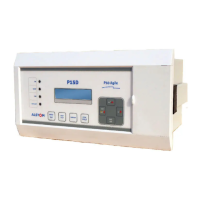The device measures and displays the following quantities:
Parameter Unit Description
IA Amp Primary current in phase A
IB Amp Primary current in phase B
IC Amp Primary current in phase C
IN Amp Primary current in phase N
Ia Amp Secondary current in phase A
Ib Amp Secondary current in phase B
Ic Amp Secondary current in phase C
In Amp Secondary current in phase N
Thermal Stage % Thermal state
In the event of a fault, the type of the fault and fault current are displayed on LCD. The IED measures
the fault current and stores it in the non-volatile memory.
2.3 Self-Diagnostic features
The P15D relay includes self-monitoring function to check the operation of its hardware and software
while in service. If there is a problem with the hardware or software, it is able to detect and report the
problem.
The relay continuously monitors the hardware and in the event detects any hardware fault/error,
corresponding error code is displayed on the LCD. These faults errors are stored in the error log file
and can be viewed from “Error Log” menu. Error log is stored as 16 bit integer. Some example of error
codes are given below:
Setting error: 0000 0000 0000 0001
RTC error: 0000 0000 0000 0100
If more than one error bits are set: the error code displayed on the LCD is the combination of these
error bits.
As an example if RTC error and Setting error occur simultaneously, then error code/error log will be as
under:
Error code : 0000 0000 0000 0101
Error log on LCD: 0005
If the error is cleared during the self-diagnostic procedure the corresponding error bit will be cleared.
In case of errors related to ‘Setting’ and ‘ADC’, P15D goes in to OUT OF SERVICE mode (Protection
function will be blocked) and the ON LED on the front facia of the relay will start blinking at 1 sec
interval. For more details, refer to the Troubleshooting section.
2.4 Interface with SCADA
Communication port RS-485 can be configured for networking with remote SCADA. The additional
binary inputs S2 & S3 are provided and can be used to monitor any additional contact, such as CB or
any other relay contact, remotely.
2.5 Binary output relay
The relay supports two output contacts: 1x self-reset and 1x latching type. The self-reset trip contact
remains closed until the fault persists and opens after fault current become less than reset value. The
latching type contact will close when a fault occurs and the relay provides trip command. This contact

